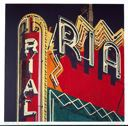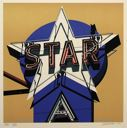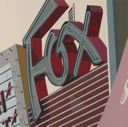Robert Cottingham
American
(Brooklyn, New York, 1935 - )
Robert Cottingham was born in Brooklyn in 1935.(1) His interest in art developed after encounters with the works of artists such as Stuart Davis, Charles Demuth, Edward Hopper, and Piet Mondrian.(2) When he was 9 or 10, he and his father also regularly began visiting Times Square where Cottingham was excited by the scale and inventiveness of the advertising signs. In 1959, Cottingham entered the Pratt Institute in Brooklyn to study advertising and graphic design. In 1963, he left the Institute and began working for the advertising agency of Young and Rubicam in New York. Also that year, Cottingham began to teach himself painting in his spare time, working at night and on weekends. His first works focused on urban subjects, an interest he has pursued throughout his career.
In 1964, Cottingham was transferred to Los Angeles. He continued to paint urban subjects, but he began to focus particularly on building facades. During his years in Los Angeles, Cottingham advanced rapidly in both his formal and technical abilities as a painter(3), and in 1968 he was offered his first show at Molly Barnes Gallery in Los Angeles. Encouraged by this success, Cottingham decided to end his advertising career and pursue art full-time.
From 1969 to 1970, Cottingham taught at the Art Center College of Design in Los Angeles, then in 1972 he decided to move to London where he lived for the next four years. Also that year, Cottingham began to experiment with printmaking which rapidly became a favorite medium. Shorewood Press asked him to participate in a lithography project called Documenta 5, along with a number of other Photorealists, and Landfall Press in Chicago also invited him to make prints of his work. In 1973, Cottingham began working with the intaglio printer, Tim Berry.
In 1974, Cottingham was awarded a National Endowment for the Arts Fellowship which allowed him to continue his residence in London. He eventually returned to the United States in 1976. Once settled, Cottingham returned to the steady pattern of work that he had established in England. He also continued to extensively exhibit his work in both one-person and group shows in Europe and the United States. In addition, he served as artist-in-residence at the Center for Creative Youth at Wesleyan University in Middletown, Connecticut from 1987 to 1992, and he taught at the National Academy of Design in New York in 1991. Currently, Cottingham's studio is located in a converted barn on a farm in Connecticut where he lives with his wife and three daughters. He continues to work and exhibit actively, and regularly lectures about his work. He is represented by Forum Gallery in New York.
The list of exhibitions in which Cottingham has participated is extensive. One-man shows of his work have occurred at least once a year since 1974, and many years there have been several throughout the United States and Europe. Since 1968, he also has participated in several group shows a year. A retrospective of his prints was held in 1986 at the Springfield Art Museum in Springfield, Missouri.(4) Cottingham's works are part of a variety of museum collections throughout the world including the Art Institute of Chicago, the Whitney Museum of American Art, the Museum of Modern Art, the Arts Council of Great Britain, the Tate Gallery, London, the Utrecht Museum in the Netherlands, the Carnegie Institute in Pittsburgh, and the St. Louis Art Museum, among many others.
Cottingham works in a variety of media. He paints in watercolor, gouache, and oil, and has tried his hand at etching, color aquatints, lithography, and woodblock printing. The creation of a Cottingham painting follows a standard procedure.(5) Cottingham first takes a photograph (usually in bright sunlight) of the facade, sign, or other object which interests him, using different lenses and angles to approach his subject in a variety of ways. Sometimes he will use an older photograph or slide from his extensive collection. The photograph serves as a point of departure for graphite drawings, which are compositional studies as well as explorations of the balance of light and shadow in a particular composition. The drawing is followed by a color study in gouache or watercolor. Only then does Cottingham begin on the oil painting. Because of this lengthy process and the cropping, selecting, and rearranging which occurs, though Cottingham's paintings are based on photographs, the end result is not a direct copy of the original picture.
Throughout his career, Cottingham has been fascinated with signs and letter forms which he at least partially attributes to his childhood visits to Times Square and his career in advertising.(6) He is particularly drawn to the neon signs of the 1930s and 1940s, though signs of all shapes, materials, and textures have captured his attention. Cottingham has explored a number of themes during his career. His earliest works focused on building facades and according to Cottingham "represent[ed] my ongoing fascination with downtown America and the visual poetry of its commercial establishments.(7)" He gradually began to focus in on fragments of the facades, particularly store signs and then, progressively, on fragments of the signs themselves. He began his Rolling Stock series of railroad cars in 1987 and followed it several years later with a series of railroad warning stripes and "Portals"—the open doors to abandoned railroad cars. Recently, he has concentrated on individual letters from signs to create his Alphabet Series.
Cottingham has been labeled both a New Realist and a Photorealist painter. He acknowledges a variety of influences on his art, most notably the Precisionists such as Charles Sheeler, Charles Demuth, and Ralston Crawford, but also Mondrian, Matisse, Franz Kline, and Richard Diebenkorn, as well as Pop Art. Photorealism emerged as a distinctive art movement in the late 1960s and came to prominence in the 1970s, the same period in which Cottingham was beginning his career. The precision and careful attention to detail in Cottingham's work is reminiscent of the work of his fellow Photorealists, but he himself has protested that photographic reproduction of his subjects is not his aim: "I don't care about being realistic. In other words, I don't put in little rust spots or bolts that show. I'm not looking for that kind of realism. I'm just using the subjects as the stepping-off points to compose the painting.(8)" One critic has pointed out that much of his work, particularly the Rolling Stock and Warning Stripes series as well as the recent Alphabet Series, border on the abstract in their concentration on pure form and color.(9) Cottingham's paintings and prints are characterized by strong light, bright color, and shallow, set-like spaces. Though his paintings are highly detailed and carefully finished, Cottingham does not try to obliterate all traces of the medium in which he is working like some of his fellow Photorealists.
(1)Biographical, technical, and stylistic information has been compiled from the following sources: Artist's vitae on file at the Montgomery Museum of Fine Arts; "The Photo-Realists: 12 Interviews", Art in America November/December 1972, pp. 73-89; John Arthur, Realism/Photorealism, Philbrook Art Center, Tulsa, Oklahoma, 1980; Lisa Nicol Peters, "Robert Cottingham", Arts Magazine, February, 1983, pp. 39-40; Alvin Martin, American Realism: Twentieth-Century Drawings and Watercolors from the Glenn C. Janss Collection, San Francisco Museum of Modern Art in association with Harry N. Abrams, Inc., New York, 1986; John Arthur, Robert Cottingham: A Print Retrospective 1972-1986, Springfield Art Museum, Springfield, Missouri, 1986; Robert Cottingham: Recent Paintings, Marisa Del Re Gallery, New York, February-March, 1993; Daniel DuBois, Robert Cottingham: Rolling Stock Series, New Britain Museum of American Art, Central Connecticut State University, New Britain, Connecticut, April-May, 1993; Dorothy Burkhart, Robert Cottingham: Modernist on the Move, Triton Museum of Art, Santa Clara, California, 1994; Elaine Gustafson, ARTnow: Robert Cottingham, Montgomery Museum of Fine Arts, August-November, 1996. (2)Arthur, 1986, p. 36. (3)Arthur, 1986, p. 26. (4)John Arthur, Robert Cottingham: A Print Retrospective 1972-1986, Springfield Art Museum, Springfield, Missouri, 1986. (5)For a detailed account of Cottingham's working methods see Arthur, 1986 and Robert Cottingham: Recent Paintings, Marisa Del Re Gallery, New York, February-March, 1993. (6)Art in America November/December 1972; Burkhart, 1994; Gustafson, 1996. (7)Robert Cottingham: Recent Paintings, Marisa Del Re Gallery, New York, February-March, 1993 (8)"The Photo-Realists: 12 Interviews", Art in America November/December 1972, p. 78. (9)"Whether Cottingham depicts architectural signs or railroad cars, he's excited by what he finds paintable in those subjects: To him they are designs investigated for their formal possibilities. The energy of his pictures comes from his preoccupation with the arrangement of spaces, surfaces, shapes and color." (Burkhart, 1994; See also Peters, 1983). M. Bullock 8/13/97
American
(Brooklyn, New York, 1935 - )
Robert Cottingham was born in Brooklyn in 1935.(1) His interest in art developed after encounters with the works of artists such as Stuart Davis, Charles Demuth, Edward Hopper, and Piet Mondrian.(2) When he was 9 or 10, he and his father also regularly began visiting Times Square where Cottingham was excited by the scale and inventiveness of the advertising signs. In 1959, Cottingham entered the Pratt Institute in Brooklyn to study advertising and graphic design. In 1963, he left the Institute and began working for the advertising agency of Young and Rubicam in New York. Also that year, Cottingham began to teach himself painting in his spare time, working at night and on weekends. His first works focused on urban subjects, an interest he has pursued throughout his career.
In 1964, Cottingham was transferred to Los Angeles. He continued to paint urban subjects, but he began to focus particularly on building facades. During his years in Los Angeles, Cottingham advanced rapidly in both his formal and technical abilities as a painter(3), and in 1968 he was offered his first show at Molly Barnes Gallery in Los Angeles. Encouraged by this success, Cottingham decided to end his advertising career and pursue art full-time.
From 1969 to 1970, Cottingham taught at the Art Center College of Design in Los Angeles, then in 1972 he decided to move to London where he lived for the next four years. Also that year, Cottingham began to experiment with printmaking which rapidly became a favorite medium. Shorewood Press asked him to participate in a lithography project called Documenta 5, along with a number of other Photorealists, and Landfall Press in Chicago also invited him to make prints of his work. In 1973, Cottingham began working with the intaglio printer, Tim Berry.
In 1974, Cottingham was awarded a National Endowment for the Arts Fellowship which allowed him to continue his residence in London. He eventually returned to the United States in 1976. Once settled, Cottingham returned to the steady pattern of work that he had established in England. He also continued to extensively exhibit his work in both one-person and group shows in Europe and the United States. In addition, he served as artist-in-residence at the Center for Creative Youth at Wesleyan University in Middletown, Connecticut from 1987 to 1992, and he taught at the National Academy of Design in New York in 1991. Currently, Cottingham's studio is located in a converted barn on a farm in Connecticut where he lives with his wife and three daughters. He continues to work and exhibit actively, and regularly lectures about his work. He is represented by Forum Gallery in New York.
The list of exhibitions in which Cottingham has participated is extensive. One-man shows of his work have occurred at least once a year since 1974, and many years there have been several throughout the United States and Europe. Since 1968, he also has participated in several group shows a year. A retrospective of his prints was held in 1986 at the Springfield Art Museum in Springfield, Missouri.(4) Cottingham's works are part of a variety of museum collections throughout the world including the Art Institute of Chicago, the Whitney Museum of American Art, the Museum of Modern Art, the Arts Council of Great Britain, the Tate Gallery, London, the Utrecht Museum in the Netherlands, the Carnegie Institute in Pittsburgh, and the St. Louis Art Museum, among many others.
Cottingham works in a variety of media. He paints in watercolor, gouache, and oil, and has tried his hand at etching, color aquatints, lithography, and woodblock printing. The creation of a Cottingham painting follows a standard procedure.(5) Cottingham first takes a photograph (usually in bright sunlight) of the facade, sign, or other object which interests him, using different lenses and angles to approach his subject in a variety of ways. Sometimes he will use an older photograph or slide from his extensive collection. The photograph serves as a point of departure for graphite drawings, which are compositional studies as well as explorations of the balance of light and shadow in a particular composition. The drawing is followed by a color study in gouache or watercolor. Only then does Cottingham begin on the oil painting. Because of this lengthy process and the cropping, selecting, and rearranging which occurs, though Cottingham's paintings are based on photographs, the end result is not a direct copy of the original picture.
Throughout his career, Cottingham has been fascinated with signs and letter forms which he at least partially attributes to his childhood visits to Times Square and his career in advertising.(6) He is particularly drawn to the neon signs of the 1930s and 1940s, though signs of all shapes, materials, and textures have captured his attention. Cottingham has explored a number of themes during his career. His earliest works focused on building facades and according to Cottingham "represent[ed] my ongoing fascination with downtown America and the visual poetry of its commercial establishments.(7)" He gradually began to focus in on fragments of the facades, particularly store signs and then, progressively, on fragments of the signs themselves. He began his Rolling Stock series of railroad cars in 1987 and followed it several years later with a series of railroad warning stripes and "Portals"—the open doors to abandoned railroad cars. Recently, he has concentrated on individual letters from signs to create his Alphabet Series.
Cottingham has been labeled both a New Realist and a Photorealist painter. He acknowledges a variety of influences on his art, most notably the Precisionists such as Charles Sheeler, Charles Demuth, and Ralston Crawford, but also Mondrian, Matisse, Franz Kline, and Richard Diebenkorn, as well as Pop Art. Photorealism emerged as a distinctive art movement in the late 1960s and came to prominence in the 1970s, the same period in which Cottingham was beginning his career. The precision and careful attention to detail in Cottingham's work is reminiscent of the work of his fellow Photorealists, but he himself has protested that photographic reproduction of his subjects is not his aim: "I don't care about being realistic. In other words, I don't put in little rust spots or bolts that show. I'm not looking for that kind of realism. I'm just using the subjects as the stepping-off points to compose the painting.(8)" One critic has pointed out that much of his work, particularly the Rolling Stock and Warning Stripes series as well as the recent Alphabet Series, border on the abstract in their concentration on pure form and color.(9) Cottingham's paintings and prints are characterized by strong light, bright color, and shallow, set-like spaces. Though his paintings are highly detailed and carefully finished, Cottingham does not try to obliterate all traces of the medium in which he is working like some of his fellow Photorealists.
(1)Biographical, technical, and stylistic information has been compiled from the following sources: Artist's vitae on file at the Montgomery Museum of Fine Arts; "The Photo-Realists: 12 Interviews", Art in America November/December 1972, pp. 73-89; John Arthur, Realism/Photorealism, Philbrook Art Center, Tulsa, Oklahoma, 1980; Lisa Nicol Peters, "Robert Cottingham", Arts Magazine, February, 1983, pp. 39-40; Alvin Martin, American Realism: Twentieth-Century Drawings and Watercolors from the Glenn C. Janss Collection, San Francisco Museum of Modern Art in association with Harry N. Abrams, Inc., New York, 1986; John Arthur, Robert Cottingham: A Print Retrospective 1972-1986, Springfield Art Museum, Springfield, Missouri, 1986; Robert Cottingham: Recent Paintings, Marisa Del Re Gallery, New York, February-March, 1993; Daniel DuBois, Robert Cottingham: Rolling Stock Series, New Britain Museum of American Art, Central Connecticut State University, New Britain, Connecticut, April-May, 1993; Dorothy Burkhart, Robert Cottingham: Modernist on the Move, Triton Museum of Art, Santa Clara, California, 1994; Elaine Gustafson, ARTnow: Robert Cottingham, Montgomery Museum of Fine Arts, August-November, 1996. (2)Arthur, 1986, p. 36. (3)Arthur, 1986, p. 26. (4)John Arthur, Robert Cottingham: A Print Retrospective 1972-1986, Springfield Art Museum, Springfield, Missouri, 1986. (5)For a detailed account of Cottingham's working methods see Arthur, 1986 and Robert Cottingham: Recent Paintings, Marisa Del Re Gallery, New York, February-March, 1993. (6)Art in America November/December 1972; Burkhart, 1994; Gustafson, 1996. (7)Robert Cottingham: Recent Paintings, Marisa Del Re Gallery, New York, February-March, 1993 (8)"The Photo-Realists: 12 Interviews", Art in America November/December 1972, p. 78. (9)"Whether Cottingham depicts architectural signs or railroad cars, he's excited by what he finds paintable in those subjects: To him they are designs investigated for their formal possibilities. The energy of his pictures comes from his preoccupation with the arrangement of spaces, surfaces, shapes and color." (Burkhart, 1994; See also Peters, 1983). M. Bullock 8/13/97
Artist Objects



